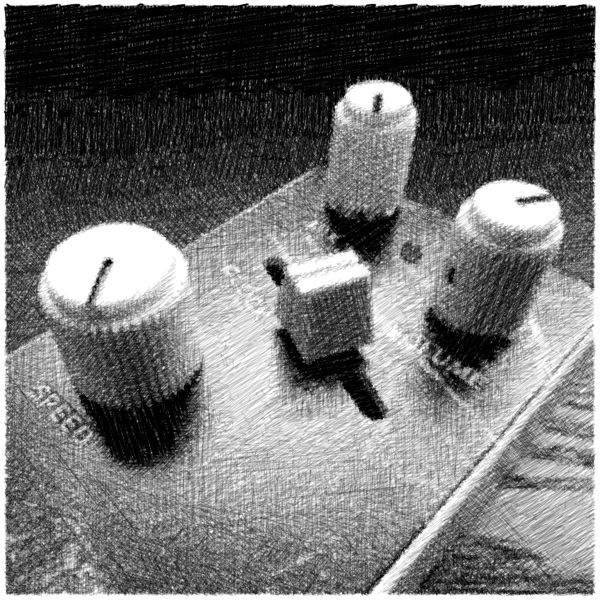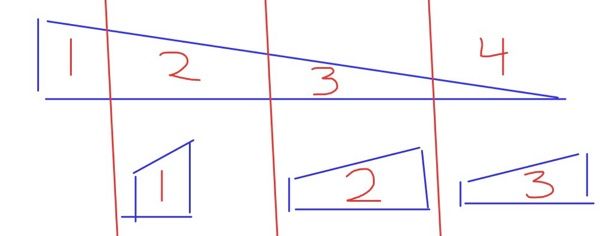Current Pedal Obsession: Old Blood BL-44 Reverse pedal.

Get ready to be taken aback.
I’m itching to explain the concept of a reverse pedal. But Einstein and the Bootstrap Paradox are involved, so let’s forget all that. Instead this article will just help you get along with the BL-44 pedal as part of your musical workflow without too much time-space continuum talk.
The BL-44 is not a delay, but the reverse function from the Old Blood Rever and Minim pedals on its own. With no repeats, it puts the raw reverse effect and its unique parameter controls in the spotlight. At first you may think BL-44 is just mocking your playing with its slicing and uneven playback. But then you’ve probably never played with the parameter of time like this before.
And so: it seams.
The nature of any reverse effect is that it reverses time in hunks and has an obvious seam at the point where the memory ends at the beginning and starts again at the end. (Got that?) Okay just one diagram.

The BL-44 is always recording and playing back. The upper blue triangle represents the volume of a dry note played. The lower represents what’s played back. The red lines represent the memory length of the BL-44 which cycles at a constant speed set by the slider. The element of chance here is that the note was played halfway through the first cycle, so the BL-44 will play just a blip of the start of the note in reverse while recording the second cycle. The third cycle plays the reversed sustain recorded in the second cycle while recording more sustain at a lower volume, etc. Since it’s chance where you start playing in the first cycle, the reverse passage can be abrupt while sustain can seem rhythmic, especially when the cycle is short. If you play to the cycle, you get rhythm. If you play against it, you get random. Your choice.
The Clock slider.
There are two parameters on BL-44 you might find out of the norm. The Clock slider controls the length and fidelity of the memory for both recording and playback. When the slider is left, it extends the memory and can bitcrush the fidelity beautifully. When the clock slider is right the fidelity is higher and the cycle is shorter. No matter where you set the slider, the pitch of the wet is at unison with the dry. But like a delay, dragging the slider creates a slew effect, bending pitch and time during the transition as the write and read heads catch up to each other.
The Speed knob.
The Speed knob controls just the quantized read speed. From 7a: -octave, -5th, -4th, unison, +4th, +5th, +octave. An added quirk to a reverse effect is that any setting but 12n on the Speed knob will also change the length of what’s being played back. Pitching-down truncates playback so only the first part of the memory gets played while pitching-up will play the memory twice to fill in the gap. As you can tell, learning the quirks is what can make this pedal so useful.
Clock + Speed = Time.
While the following explanation isn’t precise, it’s in the ballpark. According to Dan at Old Blood (who explains it all) the memory of the BL-44 records .25 seconds (when flush right) to about 4 seconds (when flush left). But then, you have to factor in that the Clock slider and the Speed knob are interactive. So once you move the Speed knob from 12n, things get longer or shorter. When the Clock slider is left and the Speed knob is at 7a, the pitched-down playback runs at half speed. When the Clock slider is right and the Speed knob is at 5p things get really fast with the memory played twice at twice speed. Especially at these faster settings the BL-44 can seem to have repeats. It does have two taps and if you have a healthy sustain of your dry signal, the sampling of the sustain can sound like repeats at this setting.
Learning reverse time: BL-44’s other parameter.
There’s a steep learning curve here. But it’s not with the simple controls. It’s in feeling the patterns of reverse time and playing with it, against it or ignoring it. Here are some tips:
- Find the cycle to create a rhythm. It’s very much like working with a tremolo at full depth. Rhythm is not necessarily about fitting your playing only within the memory length to hide the seam (though that’s a cool effect when the clock is slow). It’s about playing at the same speed as the read head, even when the dry and wet don’t coincide.
- Do some expanse exploration with the Clock slider. It’s similar to the Roland Space Echo’s Twist mode. No matter where you move it, the pitch returns to normal after a few seconds.
- Adjust the Speed knob for pitched steps on the fly. Try “playing” the knob, especially between the 4th and 5th settings on either side.
- Set the mix of the wet signal low and it becomes random ambience to whatever you’re playing.
Where BL-44 fits into your chain.
BL-44 produces a primitive result that welcomes other effects to complete it. Here are a few ideas:
- Put the BL-44 anywhere in your chain. The most practical place is probably after compression and before ambience, but…
- Put vibrato after it. With a conventional vibrato, like the Joe Gore Purr in the demo above, it can sound violinish or organish. With a random vibrato like the Mid-Fi Random Vibrato or Pladask Elektrisk Falma that create unpredictable pitch modulation, the added wow and flutter can sound like reverse tape.
- Try distortion both before and after. It can sound very different, so experiment.
- Add a delay afterwards. Wait: wasn’t the BL-44 effect removed from a delay pedal in the first place? Yes, but a delay that’s not married to the reverse memory cycle can be incredibly inspiring, especially when delay repeats are out-of-sync. It can create a wonderfully disjointed ambience that delays with reverse programs just can’t achieve.
- Reverse the reverse. Put the BL-44 before a reverse delay to for some unpredictable glitching.
- Put the BL-44 in the effects loop of a forward delay to turn it into a reverse delay. Set the Speed knob on the BL-44 anywhere but 12n and you have an arpeggiating reverse delay as in the demo with the Pladask Taken below. The Fairfield Hors D’Oeuvre, and Rockett APE are feedback loop pedals that work similarly with BL-44 in their loop.
My take.
The lack of a feedback knob on the BL-44 will likely have you playing this pedal is a very different way than you would a reverse program on a delay pedal. What I really like about the raw nature of the effect is that you can let it shine by itself or use it as a building block with other pedals. Parameter control may seem sparse until you start messing with the Clock slider and Speed knob. They each warp reverse time in different ways and it may take a while to wrap your head around what’s going on.
A bonus over most reverse effects is the degradation when the Clock slider is all the way left and crushing the reverse signal into something so slow and digitally primitive you’ll swear you’re hearing the ones and zeroes. If you really like Hendrix-out with the reverse effect, but’ve found the reverse program on your delay pedal too predictable or a hassle to get to, this is likely the pedal for you.
For the spectators: Spin FV-1 DSP, 110mA, .25-2.5 sec memory, momentary/latching footswitch, Mix to 100% wet.
Want to know how much companies pay players to demo their pedals? I really wouldn’t know since they pay me zilch and I bought for this pedal with my own, hard-earned coffees.
